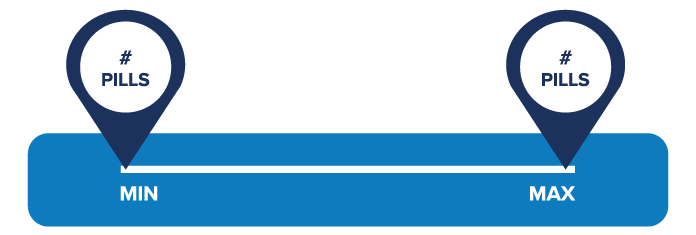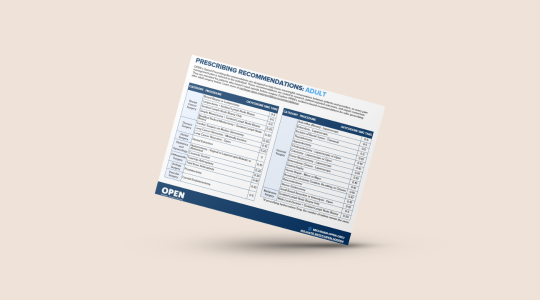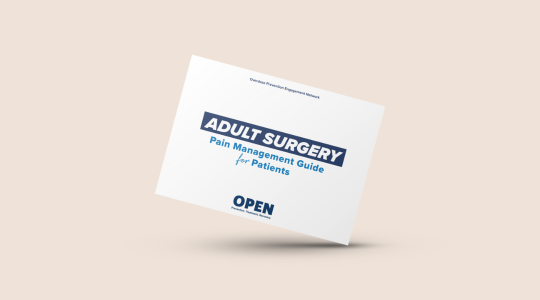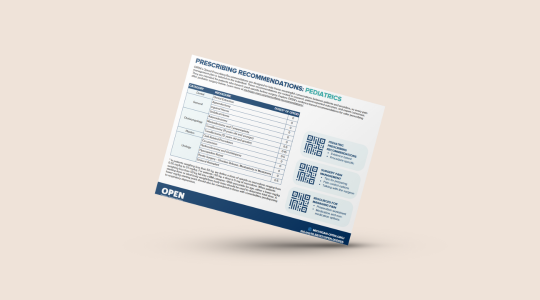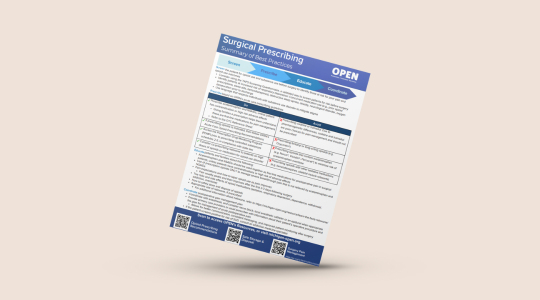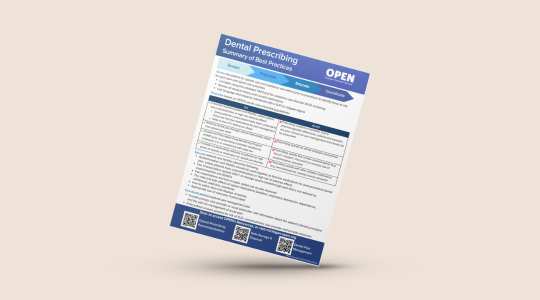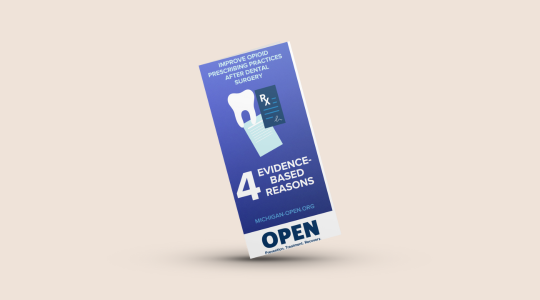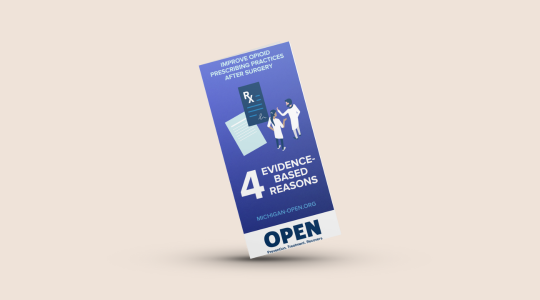Breast Cancer Surgery
Oxycodone 5mg tablets*
Breast Biopsy or Lumpectomy
0-5
SUPPORTING LITERATURE
Lee et al. 2019 (Level 2 evidence)
- DOI: http://doi.org/10.1245/s10434-018-6772-3
- Analyzed data from 847 patients who underwent breast or melanoma procedures between June 2016-September 2017 at a single institution.
- Mastectomy or wide local excision for melanoma: mean opioid prescribed = 13 pills
- Lumpectomy or breast biopsy: mean opioid prescribed = 12 pills (oxycodone 5 mg)
Lumpectomy + Sentinel Lymph Node Biopsy
0-5
SUPPORTING LITERATURE
Lee et al. 2019 (Level 2 evidence)
- DOI: http://doi.org/10.1245/s10434-018-6772-3
- Analyzed data from 847 patients who underwent breast or melanoma procedures between June 2016-September 2017 at a single institution.
- Mastectomy or wide local excision for melanoma: mean opioid prescribed = 13 pills
- Lumpectomy or breast biopsy: mean opioid prescribed = 12 pills (oxycodone 5 mg)
Sentinel Lymph Node Biopsy Only
0-5
SUPPORTING LITERATURE
Lee et al. 2019 (Level 2 evidence)
- DOI: http://doi.org/10.1245/s10434-018-6772-3
- Analyzed data from 847 patients who underwent breast or melanoma procedures between June 2016-September 2017 at a single institution.
- Mastectomy or wide local excision for melanoma: mean opioid prescribed = 13 pills
- Lumpectomy or breast biopsy: mean opioid prescribed = 12 pills (oxycodone 5 mg)
Simple Mastectomy + Sentinel Lymph Node Biopsy
0-20
SUPPORTING LITERATURE
Lee et al. 2019 (Level 2 evidence)
- DOI: http://doi.org/10.1245/s10434-018-6772-3
- Analyzed data from 847 patients who underwent breast or melanoma procedures between June 2016-September 2017 at a single institution.
- Mastectomy or wide local excision for melanoma: mean opioid prescribed = 13 pills
- Lumpectomy or breast biopsy: mean opioid prescribed = 12 pills (oxycodone 5 mg)
Modified Radical Mastectomy or Axillary Lymph Node Dissection
0-30
SUPPORTING LITERATURE
Lee et al. 2019 (Level 2 evidence)
- DOI: http://doi.org/10.1245/s10434-018-6772-3
- Analyzed data from 847 patients who underwent breast or melanoma procedures between June 2016-September 2017 at a single institution.
- Mastectomy or wide local excision for melanoma: mean opioid prescribed = 13 pills
Dentistry
Oxycodone 5mg tablets*
SUPPORTING LITERATURE
Akinbade et al. 2022 (Level 1 evidence)
- DOI: 10.1403/njcp.ncjp_544_18
- RCT with 90 patients undergoing impacted third molar extraction randomized to receive either tramadol or celecoxib.
- Greater pain control and tolerability with celecoxib than with tramadol
Freilich et al. 2020 (Level 3 evidence)
- DOI: 10.1016/j.joms.2020.02.032
- Survey was sent to 118 oral and maxillofacial surgeons and collected self-reported data on opioid prescribing patterns for dental extractions.
- 92% of respondents do not regularly prescribe opioids to their patients; opioids are prescribed regularly in small amounts (8-12 doses) for a select few invasive procedures, such as the placement of 6 or more dental implants.
Resnick et al. 2019 (Level 3 evidence)
- DOI: https://doi.org/10.1016/j.joms.2019.02.011
- Prospective cohort study of 81 patients who had asymptomatic third molars extracted at a single institution from June 2018- October 2018
- Average number of oxycodone tablets used was 0.04 ± 0.24
- Highest daily use of opioids was on POD2 (1.0 ± 0.0 tablet)
- Only 6 patients (7%) used opioids during the postoperative period (average of 3.3 tablets per patient)
- 93% used no postoperative opioids; 466 prescribed tablets remained unfilled or unused
- Ibuprofen 600 mg was used by 89% for a mean of 4.6 ± 2.2 PODs; Highest daily use on POD2 (mean of 2.8 ± 0.8 tablets
- Acetaminophen 650 mg was used by 86% for a mean of 3.4 ± 1.9 PODs; Highest daily use on POD2 (mean of 4.2 ± 1.8 tablets)
- Female patients took 8.9 times more postoperative analgesic medication than male patients
Nalliah et al. 2020 (Level 3 evidence)
- DOI: 10.1001/jamanetworkopen.2020.0901
- Analyzed data from 329 patients who underwent a routine (174) or surgical (155) dental extraction procedure at a single institution between 1 June 2017- 31 December 2017
- Routine extraction = required no conjunctive removal of bone of extraction of soft tissue because teeth were visible an above gum line
- Surgical extraction = required an incision into the connective tissue to expose teeth
- Surgical extraction: 70.3% were prescribed opioids and 51.6% used opioids after surgical extraction
- Routine extraction: 49.4% were prescribed opioids and 39.1% used opioids after routine extraction
- Opioid users were younger and more likely to be female
- Of those that did not take an opioid, 61.3% used medications such as ibuprofen, celecoxib, or naproxen sodium and 33.3% used acetaminophen or NSAIDS to treat pain after leaving the dental clinic
- Opioid group reported higher pain levels
- No difference in satisfaction scores between opioid and nonopioid group
General Surgery
Oxycodone 5mg tablets*
Anti-reflux (nissen) - Laparoscopic
0-5
DATA ANALYSIS
- Patient Reported Outcomes data collected via Michigan Surgical Quality Collaborative
- January 1, 2018 – October 31, 2021
- 609 Opioid Naïve Patients from 55 Michigan Hospitals
SUPPORTING LITERATURE
Haskins et al 2021 (Level 3 evidence)
- DOI: https://doi.org/10.1007/s00464-022-09123-y
- Analyzed data from 17,530 patients who underwent laparoscopic fundoplication, hiatal hernia repair, or Heller myotomy from 2010 to 2018.
- 9652 patients had at least one opioid prescription filled in the perioperative period.
- 0.4% were found to have persistent postoperative opioid use at 365 days postoperatively.
- The risk of progression to persistent postoperative opioid use was less than 1%.
- Persistent postoperative opioid use was most common during the first 30 days.
Enterolysis - Laparoscopic
0-5
DATA ANALYSIS
Enterolysis – Laparoscopic
- Patient Reported Outcomes data collected via Michigan Surgical Quality Collaborative
- January 1, 2018 – October 31, 2021
- 64 Opioid Naive Patients from 31 Michigan Hospitals
SUPPORTING LITERATURE
Chiem et al. 2022 (Level 2 evidence)
- DOI: https://doi.org/10.1097/pq9.0000000000000548
- 641 patients (3yo-18yo) were assigned to study groups based on time period, and were given either standard anesthesia, multimodal anesthesia, or opioid-free anesthesia for inguinal hernia repair. Pain scores were measured.
- Opioids can be safely minimized without sacrificing satisfaction with pain management. Only 12% of patients required a rescue dose of morphine in PACU.
Hageman et al. 2022 (Level 3 evidence)
- DOI: https://doi.org/10.1016/j.jpedsurg.2022.02.039
- Retrospective review of 15 studies were compared with a retrospective review of patients at the authors’ institution. Opioid use was analyzed.
- Opioids were mostly administered while admitted during the first 24h after surgery. One institution used opioids sparingly in PACU and successfully eliminated opioid prescriptions at discharge.
Svetanoff et al. 2022 (Level 2 evidence)
- DOI: https://doi.org/10.1016/j.jpedsurg.2021.10.012
- Patients were contacted 1-4 weeks after different day surgeries and were surveyed about opioid use. Results between procedure types were compared.
- 89% of inguinal hernia patients filled opioid scripts at discharge, and 91% of those opioids went unused. 94% of patients using non-opioid pain relief methods were satisfied with pain management.
Excision of Rectal Tumor - Transanal
0-5
DATA ANALYSIS
Transanal Excision of Rectal Tumor
- Patient Reported Outcomes data collected via Michigan Surgical Quality Collaborative
- January 1, 2018 – October 31, 2021
- 71 Opioid Naive Patients from 19 Michigan Hospitals
SUPPORTING LITERATURE
Swaraup et al. 2018 (Level 3 evidence)
- DOI: https://doi.org/10.1016/j.jss.2018.04.005
- Analyzed opioid prescribing trends and patient use of opioids for 42 outpatient anorectal operations at a single institution from May 2016-April 2017. Procedures included 6 transanal excision of rectal tumors.
- 90% were prescribed opioids postoperatively with a median of 20 pills (range 0-120 pills)
- For those prescribed an opioid, the median number of pills taken was 4.
- 80% of pills prescribed were not used.
- Most patients had adequate pain control after surgery with little to no use of opioids.
DATA ANALYSIS
Thyroidectomy
- Patient Reported Outcomes data collected via Michigan Surgical Quality Collaborative
- January 1, 2018 – October 31, 2021
- 814 Opioid Naive Patients from 57 Michigan Hospitals
SUPPORTING LITERATURE
Lou, I. 2017
- DOI: https://doi.org/10.1245/s10434-017-5781-y
- Annals of surgical oncology
- Analyzed data from patients undergoing thyroid and parathyroid surgery at two large academic institutions from 1 January-30 May 2014.
- 83% of patients took ten or fewer OMEs, and 93% took 20 or fewer OMEs.
Shindo et al. 2018
- DOI: 10.1001/jamaoto.2018.2427
- Analyzed data from 1702 individuals who underwent thyroid and parathyroid surgery as a single institution from 1 January 2012-31 December 2017.
- 57.5% were discharged without any opioid prescription for parathyroidectomy, 37.5% for hemithyroidectomy, and 33.3% for total thyroidectomy.
- Recommended prescription = “little, if any, postoperative opioids”
Sada, A. The Journal of surgical research. 2020. (Level 3 Evidence)
- https://doi.org/10.1016/j.jss.2019.07.039
- Analyzed data from patients undergoing parathyroidectomy at three institutions between 13 March 2017 – 19 January 2018
- A total of 91 patients were included; 90% were opioid-naive.
- Median prescribed was 10 pills but median consumed was 0 pills
- Over 50% of patients undergoing parathyroidectomy did not consume any opioid, and very few needed more than 2 doses of opioid.
- Top users reported higher pain scores than standard users
- Of those receiving a prescription, 94.6% had left-over opioids at the time of survey meaning that 82% of prescribed opioids were unused.
Appendectomy – Laparoscopic or Open
0-10
DATA ANALYSIS
Laparscopic Appendectomy
- Patient Reported Outcomes data collected via Michigan Surgical Quality Collaborative
- January 1, 2018 – October 31, 2021
- 3887 Opioid Naive Patients from 70 Michigan Hospitals
Open Appendectomy
- Patient Reported Outcomes data collected via Michigan Surgical Quality Collaborative
- January 1, 2018 – October 31, 2021
- 241 Opioid Naive Patients from 53 Michigan Hospitals
SUPPORTING LITERATURE
Dr. Robert Bree Collaborative & Agency Medical Directors’ Group (Level 4 evidence)
Cholecystectomy – Laparoscopic or Open
0-10
DATA ANALYSIS
Laparoscopic Cholecystectomy
- Patient Reported Outcomes data collected via Michigan Surgical Quality Collaborative
- January 1, 2018 – October 31, 2021
- 9877 Opioid Naive Patients from 70 Michigan Hospitals
Open Cholecystectomy
- Patient Reported Outcomes data collected via Michigan Surgical Quality Collaborative
- January 1, 2018 – October 31, 2021
- 242 Opioid Naive Patients from 50 Michigan Hospitals
SUPPORTING LITERATURE
Hlavin et al. 2022 (Level 2 evidence)
- DOI: https://doi.org/10.3390/jcm11185453
- Analyzed data from veterans at the Veteran’s Affairs Pittsburgh Healthcare System (VAPHS) who underwent a cholecystectomy, inguinal hernia repair, or an umbilical hernia repair between November 2019-October 2020
- Recommended opioid prescription for cholecystectomy: 8 pills
- Number of days prescribed = 2.8
Colectomy – Laparoscopic or Open
0-10
DATA ANALYSIS
Laparoscopic Colectomy
- Patient Reported Outcomes data collected via Michigan Surgical Quality Collaborative
- January 1, 2018 – October 31, 2021
- 1735 Opioid Naive Patients from 65 Michigan Hospitals
Open Colectomy
-
- Patient Reported Outcomes data collected via Michigan Surgical Quality Collaborative
- January 1, 2018 – October 31, 2021
- 1262 Opioid Naive Patients from 69 Michigan Hospitals
SUPPORTING LITERATURE
Vu et al. 2022 (Level 3 evidence)
- DOI: http://doi.org/10.1097/SLA.0000000000004240
- Retrospective observational study of patients undergoing minimally invasive or open colectomy from January 2017- May 2018. Analyzed data from 562 patients at 43 institutions.
- No difference in opioid consumption or likelihood of using no opioids between open vs minimally invasive colectomy. discharge. The size of the postoperative prescription, patient age, and diagnosis are more important in determining opioid use.
- Age > 65yo and diagnosis of cancer/adenoma were associated with less opioid use
- Patients only used 28% of the opioid tablets prescribed
Nguyen et al. 2019 (Level 2 evidence)
- DOI: https://doi.org/10.1016/j.jsurg.2019.11.010
- Prospective cohort study of opioid naive patients who underwent general surgery at a single institution between November 2017- February 2018.
- Patients who underwent laparoscopic surgery were prescribed 18.3% fewer MME.
- Smaller prescription amounts were not associated with an increased rate of opioid refills.
- 19.1% of patients who were given a prescription did not fill it and patients were not less likely to fill their prescriptions after opioid counseling.
Bleicher et al. 2021 (Level 3 evidence)
- DOI: http://doi.org/10.1016/j.jss.2021.01.048
- Retrospective study of 596 patients who underwent major abdominal surgery at a single institution. Assessed inpatient opioid use and discharge prescriptions.
- Median length of stay = 3.5 days
- Discharge prescription = 5.1 days
- Lack of patient-centered opioid prescribing led to an over- and under prescribing of opioids for patients.
Eurosurg Collaborative 2019 (Level 3 evidence)
- DOI: 10.1002/bjs.11326
- Cohort study including 4164 patients undergoing elective colorectal resection between January- April 2018
- Mean time to gastrointestinal recovery did not differ significantly between patients who received NSAIDs and those who did not
- Mean recovery time for patients receiving NSAIDS = 4-6 days
- Mean recovery time for patients not receiving NSAIDS = 4-8 days
- Conclusion: NSAIDs did not reduce recovery time after colorectal surgery, but they did reduce postoperative opioid requirement.
Donor Nephrectomy - Laparoscopic
0-10
SUPPORTING LITERATURE
Marti et al. 2021 (Level 2 evidence)
- DOI: https://doi.org/10.3390/jcm11185453
- Retrospective chart review comparing pain management in a historical cohort (control) compared to pain management in a test cohort that used multimodal analgesia
- Multimodal cohort patients had lower pain scores on POD 0, POD 1, and POD 2 compared to historical cohort patients using opioid PCA
Brown et al. 2019 (Level 2 evidence)
- DOI: 10.1308/rcsann.2019.0172
- Analyzed data from 81 patients undergoing laparoscopic living-donor nephrectomy over a 25-month period at a single institution between 17 April 2013 and 20 May 2015.
- All patients up to 8 October 2013 received standard perioperative care while the rest followed an enhanced recovery protocol.
- Standard care = Analgesia provided with six-hourly intravenous paracetamol and patient-controlled morphine administration as required.
- Enhanced recovery = No intravenous fluid was administered. Patients were given a carbohydrate drink and received counseling prior to surgery. Analgesia was six-hourly intravenous paracetamol with oral oxycodone administration for breakthrough pain as required.
- Administered intraoperative fluid volume and time spent in the post-anesthetic care unit was relatively similar between the standard and the enhanced recovery group
- Conclusion: “Enhanced recovery for living-donor nephrectomy is a safe approach for donors and recipients.”
Dong et al 2022 (Level 2 evidence)
- DOI: https://doi.org/10.1016/j.jclinane.2022.110751
- Retrospective analysis of 929 laparoscopic donor nephrectomy patients at a single institution from 3 April 2019- 9 June 2020
- Adoption of ERAS protocol led to a significant reduction in intraoperative fentanyl use and a significant increase in intraoperative
hydromorphone use.
- ERAS protocol = +/− fentanyl 50μg for induction and intubation, hydromorphone 0.4 mg 10 min prior to incision, acetaminophen 1000 mg, ketorolac 30 mg per surgeon if estimated blood loss (EBL) was less than 300 ml and titrate hydromorphone 0.2 to 0.4 mg as needed at conclusion of surgery.
- Saw a significant reduction in opioid use with ERAS protocol, but no change in pain scores
Talwar et al. 2020 (Level 2 evidence)
- DOI: https://doi.org/10.1089/end.2019.0362
- Analyzed data from 170 patients undergoing laparoscopic donor nephrectomy at a single institution between September 2018- January 2019
- Implemented a standardized nonopioid analgesia pathway
- 87 patients underwent robot-assisted radical prostatectomy (RARP), 25 patients underwent robot-assisted radical nephrectomy (RARN), and 58 patients underwent robot-assisted partial nephrectomy (RAPN)
- Before September 2018, 100% of patients were discharged on varying amounts of oxycodone (range: 75–337.5 MME)
- After implementation:
- 67.7% were discharged without opioids
- 24.4% were discharged with 10 pills of tramadol (50 MME)
- 8.2% were discharged with 10 pills of oxycodone (75 MME)
- Needed for opioids at discharge decreased with older age
- No difference in pain scores between those discharged with and without opioids
- Conclusion: “The majority of robotic surgery patients do not require opioids upon discharge”
Enterostomy Closure – Laparoscopic
0-10
DATA ANALYSIS
Enterostomy Closure – Laparoscopic
- Patient Reported Outcomes data collected via Michigan Surgical Quality Collaborative
- January 1, 2018 – October 31, 2021
- 55 Opioid Naive Patients from 26 Michigan Hospitals
DATA ANALYSIS
Gastrorrhaphy
- Patient Reported Outcomes data collected via Michigan Surgical Quality Collaborative
- January 1, 2018 – October 31, 2021
- 66 Opioid Naive Patients from 30 Michigan Hospitals
Hernia Repair – Minor or Major
0-10
DATA ANALYSIS
Minor Hernia Repair
- Patient Reported Outcomes data collected via Michigan Surgical Quality Collaborative
- January 1, 2018 – October 31, 2021
- 11473 Opioid Naive Patients from 70 Michigan Hospitals
Major Hernia Repair
- Patient Reported Outcomes data collected via Michigan Surgical Quality Collaborative
- January 1, 2018 – October 31, 2021
- 1604 Opioid Naive Patients from 68 Michigan Hospitals
SUPPORTING LITERATURE
Lindros et al. 2022 (Level 2 evidence)
- DOI: https://doi.org/10.1016/j.jss.2022.09.021
- Implementation of a patient-tailored opioid prescribing guideline for patients undergoing ventral hernia surgery at a single institution between March 2018-December 2019.
- Assessed opioid utilization and patient reported outcomes of 163 patients
- MME prescribed at discharge was lower for patients receiving guideline-based care (median = 65) than standard care (median = 100)
- The odds of receiving an opioid prescription after discharge did not differ between the groups. Pain scores did not differ
- Conclusion: patients who received tailored guideline prescriptions were discharged with lower dosages and did not require more opioid refills than patients receiving standard opioid prescriptions.
Gentle et al. 2022 (Level 3 evidence)
- DOI: https://doi.org/10.1007/s10029-022-02708-5
- Analyzed data from 490 patients who underwent a laparoscopic inguinal hernia repair (LIHR) at a single institution between March 2019- March 2021
- Collected information on opioid prescriptions at discharge and opioid refills
- Median number of tablets prescribed = 12 – 12% of patients were prescribed ≤ 5 tablets, 31% were prescribed 6-10 tablets, 40% 11-15 tablets, and 17% > 15 tablets – 46% of patients reported using 0 tablets after discharge, 70% reported using ≤ 4 tablets, and 84% reported using no more than 10 tablets
- Only 4% requested a refill and there was a 12% increase in odds of opioid refill for every 1 tablet of oxycodone prescribed at discharge
- Recommended prescription: 0-10 tablets
- Conclusion: “Most patients use fewer opioid tablets than prescribed” and “requests for opioid refills are rare following LIHR (4%)”
Ciampa et al. 2022 (Level 2 evidence)
- DOI: 10.1007/s00464-022-09464-8.
- Collected data on pre-intervention and post-intervention prescribing habits for patients undergoing hernia repair surgery between 31 December 2018- 11 December 2020. Postoperative surveys were administered to all patients during or after 2-week postoperative visit.
- Included data from 131 patients
- Average prescription size decreased from 12.29 tablets to 6.8 tablets per surgery after intervention.
- Percentage of unused pills decreased from 70.5% pre-intervention to 48.5% post-intervention
- No increase in number of refills between pre- and post-intervention
- Patients reported higher satisfaction with current surgeries compared to prior surgeries.
- Recommended prescription for inguinal hernia surgery = 5-7 tablets
- Recommended prescription for ventral hernia surgery = 4.5-8.5 tablets
Knight et al. 2019 (Level 3 evidence)
- DOI: https://doi-org.proxy.lib.umich.edu/10.1053/j.jfas.2022.01.022
- Analyzed data from 195 opioid-naive patients undergoing open or minimally invasive surgery (MIS) inguinal hernia repair at three institutions between 13 March 2017- 19 January 2018
- Included unilateral and bilateral hernia repairs
- Overall patient cohort stopped utilizing opioids 3.2 ± 4.0 days after inguinal hernia repair
- Median opioids consumed after 26 days post-discharge = 2 tablets
- 91.6% of patients had opioids left over after 26 days post-discharge
- Opioid prescription and consumption were similar for open and MIS inguinal hernia repair
- Both groups had similar amounts of unused opioids (open 16 vs minimally invasive 15)
- More than 1/3 of patients required no opioids after discharge (38% of open patients and 44% of MIS patients did not consume opioids)
- Recommended prescription for open and MIS hernia repair = 0-8 tablets
Ileostomy/Colostomy Creation, Re-siting, or Closure
0-10
DATA ANALYSIS
Ileostomy/colostomy Creation, re-siting, or closure
- Patient Reported Outcomes data collected via Michigan Surgical Quality Collaborative
- January 1, 2018 – October 31, 2021
- 379 Opioid Naive Patients from 56 Michigan Hospitals
SUPPORTING LITERATURE
Aryaie et al. 2018 (Level 1 evidence)
- DOI: https://doi.org/10.1007/s00464-018-6062-y
- Randomized study in which 97 patients undergoing colorectal surgery received either IV acetaminophen or placebo in addition to opioid PCA.
- Mean opioid consumption in study group = 2.86 ± 0.24 pills at 24hrs and 4.6 ± 0.44 pills at 48hrs
- Mean opioid consumption in control group = 4.9 ± 0.55 pills at 24 hrs and 7.96 ± 0.9 pills at 48 hrs
- Conclusion: IV acetaminophen helps to reduce opioid consumption for patients undergoing colorectal surgery.
Meyer et al. 2020 (Level 3 evidence)
- DOI: http://doi.org/10.1097/SLA.0000000000005025
- Cohort study of elective colorectal operations at a single institution from September 2019-Febuary 2020. Included 201 patients (100 patients before and 101 after guideline adoption).
- Saw a 41% reduction in mean prescription quantity and 53% reduction in excess pills per prescription.
- Saw no change in opioid consumption or refill rates
- Mean quantity of opioids prescribed after guideline adoption = 10.3 pills
- Mean opioid consumption after guideline adoption = 5.2 pills
DATA ANALYSIS
Pancreatectomy
- Patient Reported Outcomes data collected via Michigan Surgical Quality Collaborative
- January 1, 2018 – October 31, 2021
- 105 Opioid Naive Patients from 20 Michigan Hospitals
SUPPORTING LITERATURE
Kluger et al. 2021 (Level 3 evidence)
- DOI: https://doi.org/10.1016/j.hpb.2021.10.021
- Analyzed data from 8325 patients undergoing pancreatomy between 2009-2017
- 35.6% used opioids within the year prior to surgery.
- Median used by opioid naive patients = 53.5 pills
- Median used by chronic opioid patients = 240 pills
- 15.1% of opioid naive patients used opioids, 77.3% of chronic opioid users used opioids, and 27.2% of intermittent users used opioids.
- Those who were prescribed ≥ 200 pills and a ≥ 14-day supply were most at risk of persistent opioid use.
- There was a 2-3 fold increase in anxiety, depression, and substance use disorder between the opioid naive and chronic patients.
Witt et al. 2022 (Level 3 evidence)
- DOI: http://doi.org/10.1002/jhbp.1216
- Analyzed data from 114 patients undergoing open or robotic pancreatectomy at a single institution between March 2019-May 2021
- Robotic PD patients required fewer opioids while maintaining similar pain scores
- Total inpatient opioid use: Robotic PD patients consumed 10.53 while open patients consumed 16.8 pills.
- Discharge prescription for robotic = 0 pills
- Discharge prescription for open = 3.3 pills
Maurer et al. 2021 (Level 2 evidence)
- DOI: http://doi.org/10.1097/SLA.0000000000005042
- Comparison of discharge opioid prescription before and after Enhanced Recovery After Surgery (ERAS) programs.
- Analyzed data from 3,983 patients undergoing hysterectomy between October 2016-November 2020 and pancreatectomy or hepatectomy between April 2017-November 2020 at a single institution.
- Matched post-ERAS patients were prescribed fewer opioid pills (17.4 pills vs.22.0 pills) and lower OME (129.4mg vs. 167.6mg) than pre-ERAS patients.
Kim et al. 2018 (Level 4 evidence)
- DOI: http://doi.org/10.1016/j.yasu.2018.03.002
- Review of pancreatomy analgesics including TAP Infiltration, Intrathecal Analgesia, Epidural Analgesia, Intravenous Patient Controlled Analgesia, and Continuous Infusion through a Wound Catheter.
- Epidural Analgesia (EA) is supported to be the most effective analgesic modality.
SUPPORTING LITERATURE
Hoehn et al. 2019 (Level 2 evidence)
- DOI: https://doi.org/10.1007/s11605-018-04091-y
- Retrospective chart review of opioid use, LOS, complications, and readmissions before and after implementation of ERAS protocol for LSG.
- After ERAS, 52% of LSG patients did not use opioids and 33% did not receive opioids of any kind.
Pardue et al. 2020 (Level 2 evidence)
- DOI: http://doi.org/10.1007/s11695-020-04980-9
- Retrospective cohort study of recovery time, pain scores, and opioid use among LSG patients before and after implementation of opioid-sparing protocol.
- Opioid-sparing protocol reduced recovery time and postoperative opioid use without changed pain scores.
Sapin et al. 2021 (Level 2 evidence)
- DOI: http://doi.org/10.1016/j.soard.2021.04.017
- Retrospective review of LOS, costs, and readmission rates before and after implementation of ERAS protocol for LSG.
- 61% fewer MMEs prescribed after ERAS, and shorter LOS with better patient outcomes.
Small Bowel Resection or Enterolysis - Open
0-10
DATA ANALYSIS
Small bowel resection or Enterolysis-open
- Patient Reported Outcomes data collected via Michigan Surgical Quality Collaborative
- January 1, 2018 – October 31, 2021
- 438 Opioid Naive Patients from 58 Michigan Hospitals
SUPPORTING LITERATURE
Spinelli et al. 2021 (Level 2 evidence)
- DOI: http://doi.org/10.1007/s11605-012-2012-5
- Analyzed data from 90 patients who underwent laparoscopic ileocecal resection at two institutions. Study then compared patients who received an enhanced recover pathway (ERP) to patients who received conventional care
- Mean postoperative and total length of stay were shorter in the ERP group as well as a significantly earlier return of bowel function
- Suggests that “optimized perioperative care combined with minimally invasive techniques may lead to further improvements in surgical outcomes for CD patients.”
Melanoma Surgery
Oxycodone 5mg tablets*
Sentinel Lymph Node Biopsy Only
0-5
SUPPORTING LITERATURE
Lee et al. 2019 (Level 2 evidence)
- DOI: http://doi.org/10.1245/s10434-018-6772-3
- Analyzed data from 847 patients who underwent breast or melanoma procedures between June 2016-September 2017 at a single institution.
- Mastectomy or wide local excision for melanoma: mean opioid prescribed = 13 pills
- Lumpectomy or breast biopsy: mean opioid prescribed = 12 pills (oxycodone 5 mg)
Wide Local Excision ± Sentinel Lymph Node Biopsy
0-20
SUPPORTING LITERATURE
Lee et al. 2019 (Level 2 evidence)
- DOI: http://doi.org/10.1245/s10434-018-6772-3
- Analyzed data from 847 patients who underwent breast or melanoma procedures between June 2016-September 2017 at a single institution.
- Mastectomy or wide local excision for melanoma: mean opioid prescribed = 13 pills
- Lumpectomy or breast biopsy: mean opioid prescribed = 12 pills (oxycodone 5 mg)
Obstetrics and Gynecology
Oxycodone 5mg tablets*
Hysterectomy – Vaginal or Laparoscopic/Robotic or Abdominal
0-10
DATA ANALYSIS
Laparoscopic Hysterectomy
- Patient Reported Outcomes data collected via Michigan Surgical Quality Collaborative
- January 1, 2018 – October 31, 2021
- 3651 Opioid Naive Patients from 56 Michigan Hospitals
Vaginal Hysterectomy
- Patient Reported Outcomes data collected via Michigan Surgical Quality Collaborative
- January 1, 2018 – October 31, 2021
- 1624 Opioid Naive Patients from 60 Michigan Hospitals
Abdominal Hysterectomy
- Patient Reported Outcomes data collected via Michigan Surgical Quality Collaborative
- January 1, 2018 – October 31, 2021
- 1202 Opioid Naive Patients from 59 Michigan Hospitals
SUPPORTING LITERATURE
DeBlanc et al. 2022 (Level 3 evidence)
- DOI: https://doi.org/10.1016/j.ajog.2021.12.114
- Analyzed data from 2,359 individuals who underwent a hysterectomy at a single institution between 1 January 2018-31 October 2019.
- Recommended prescription for abdominal hysterectomy = 7 tablets.
- Recommended prescription for laparoscopic or vaginal hysterectomy = 5 tablets.
SUPPORTING LITERATURE
Peahl et al. 2023
Osmundson et al. 2018
- DOI: https://doi.org/10.1097/aog.0000000000002782
- Individualized prescribing resulted in median of 14 tablets prescribed without differences in PROS.
- Patients in the individualized group reported using only half the number of prescribed opioids
Holland et al. 2019
- DOI: https://doi.org/10.1097/aog.0000000000003010
- Implementation of an opioid-free postpartum pathway decreased discharge prescribing
- Of those requiring a prescription, median was equivalent to15 tablets oxycodone.
- No change in pain scores or overall satisfaction with pain relief
Orthopaedic Surgery
Oxycodone 5mg tablets*
Total Hip Arthroplasty
0-30
SUPPORTING LITERATURE
Atwood et al. 2021 (Level 3 evidence)
- DOI: http://doi.org/10.1016/j.artd.2020.12.021
- 61 patients undergoing THA were prescribed 84 doses of 5mg oxycodone and were surveyed at 2 weeks and 6 weeks postoperatively regarding consumption.
- At 2 weeks, an average of 28.1 doses were taken. At 6 weeks, an average of 31.9-33.1 doses were taken.
Cunningham et al. 2021 (Level 3 evidence)
- DOI: https://doi.org/10.1186/s13011-021-00410-w
- Descriptive study using a national database to compare perioperative opioid filling volumes and rates in 487,942 patients undergoing primary total hip arthroplasty between 2010-2018.
- Initial opioid filling volume has not changed; however, the overall cumulative opioid filling volume has decreased 26% since 2010.
- States with legislation had larger magnitude of reductions in both initial and cumulative filling volume compared to states without legislation.
Zhao & Davis 2019 (Level 4 evidence)
- DOI: https://doi.org/10.1016/j.ijnurstu.2019.06.010
- Literature review on patient recovery after total hip arthroplasty
- Data collected by 26 September 2017- 12 March 2018 and included 605 articles collected from PubMed, Embase, and CINAHL.
- Non-opioid interventions such as acetaminophen, nonsteroidal anti-inflammatory drugs, cyclooxygenase-2 inhibitors, gabapentinoids, ketamine, peripheral nerve blocks, and local infiltration analgesia benefit patients after total hip arthroplasty for pain management.
- Recommend non-opioid interventions for effective pain management following total hip arthroplasty.
Nouraee et al. 2021 (Level 3 evidence)
- DOI: http://doi.org/10.1097/JHQ.0000000000000309
- Analyzed data from 3,142 patients undergoing total hip arthroplasty at five institutions between 23 August 2018- 23 August 2019.
- Mean inpatient opioids prescribed = 48.4 pills. Mean consumed = 27.3 pills
- Mean outpatient opioids prescribed = 40.9 pills. Mean consumed = 19.9 pills
Dattilo et al. 2020 (Level 3 evidence)
- DOI: https://doi.org/10.1016/j.arth.2020.04.089
- Retrospective analysis of patients undergoing total hip and total knee arthroplasty at a single institution between October 2017- August 2019
- (THA) Mean opioids consumed by opioid naive patients = 17 ± 15 pills.
- Postoperative prescription of 45 pills was sufficient for nearly 90% of THA patients.
- THA patients consumed less opioids and for a shorter duration than TKA patients.
Roberts et al. 2020 (Level 3 evidence)
- DOI: https://doi.org/10.1016/j.arth.2019.08.036
- Analyzed data from 723 opioid-naive patients at 7 hospitals in Michigan who underwent TKA (426 patients) and THA (297 patients). Patients were contacted within 3 months after surgery.
- Mean OME prescribed for TKA = 632mg. Mean consumed = 416mg.
- Mean OME prescribed for THA = 584mg. Mean consumed = 285mg.
- Recommended postoperative prescription = 50 pills for TKA and 30 pills for THA.
Tollemar et al. 2022 (Level 3 evidence)
- DOI: 10.1016/j.arth.2022.10.038
- Retrospective analysis of 120,889 opioid-naive patients who underwent THA and TKA between Jan 2015 and Nov 2019 and looked at prescription fill rates. – 30-day prescription fill rate for TKA = 59.6%
- 30-day prescription fill rate for THA = 26.1% – Odds of refill decreased by 2% (for THA) and 3% (for TKA) for every 75 OME added to the initial prescription (marginal increase that supports prescribing smaller amounts due to the small risk of needing refills)
Hannon et al. 2019 (Level 1 Evidence)
- DOI: 10.1016/j.arth.2019.01.065
- RCT prescribing either 30 (161 patients) or 90 (143 patients) 5mg OxyIR pills at discharge after undergoing THA and TKA.
- No difference in MME consumed at 90 days. No difference in pain scores at 30 days or outcome scores at 6 weeks.
MARCQI 2020 (Level 4 Evidence)
- marcqi.org
- Discuss alternatives and opioid-weaning strategies with patients
- Avoid prescribing benzodiazepines with opioids, only prescribe one opioid at a time, and prescribe naloxone for high-risk patients
- Initial prescriptions should be less than 240 OME (for THA) or 320 OME (for TKA). Supplement with acetaminophen.
Total Knee Arthroplasty
0-40
SUPPORTING LITERATURE
Thompson et al., 2022 (Level 4 evidence)
- DOI: http://doi.org/10.1177/23259671211009263
- Analyzed data from 168 patients undergoing ACLR, knee arthroscopies, or arthroscopic rotator cuff repairs over a 17-month period between June 2017- November 2018 performed at a single institution.
- Mean opioid consumption for knee arthroscopies was 7.2 ± 5.4.
- Patients consumed 47% of opioids prescribed (prescribed 15, consumed 7 on average).
- Recommended postoperative prescription = 10 pills.
Gazendam et al., 2022 (Level 1)
- DOI: http://doi.org/10.1001/jama.2022.16844
- Analyzed data from 200 patients undergoing outpatient arthroscopic shoulder or knee surgery from March 2021-March 2022 performed at 3 clinical institutions in Canada.
- Patients in opioid-sparing group for knee arthroscopies consumed 0-8 pills.
- Mean OMEs consumed in opioid-sparing group for knee arthroscopies was 8.4 mg.
Nouraee et al. 2021 (Level 3 evidence)
- DOI: http://doi.org/10.1097/JHQ.0000000000000309
- Analyzed data from 5,084 patients undergoing total knee arthroplasty at five institutions between 23 August 2018- 23 August 2019.
- Mean inpatient opioids prescribed = 56.6 pills. Mean consumed = 39.9 pills.
- Mean outpatient opioids prescribed = 49.3 pills. Mean consumed = 33.4 pills.
Roberts et al. 2020 (Level 3 evidence)
- DOI: https://doi.org/10.1016/j.arth.2019.08.036
- Analyzed data from 723 opioid-naive patients at 7 hospitals in Michigan who underwent TKA (426 patients) and THA (297 patients). Patients were contacted within 3 months after surgery.
- Mean OME prescribed for TKA = 632mg. Mean consumed = 416mg.
- Mean OME prescribed for THA = 584mg. Mean consumed = 285mg.
- Recommended postoperative prescription = 50 pills for TKA and 30 pills for THA.
Tollemar et al. 2022 (Level 3 evidence)
- DOI: 10.1016/j.arth.2022.10.038
- Retrospective analysis of 120,889 opioid-naive patients who underwent THA and TKA between Jan 2015 and Nov 2019 and looked at prescription fill rates. – 30-day prescription fill rate for TKA = 59.6%
- 30-day prescription fill rate for THA = 26.1% – Odds of refill decreased by 2% (for THA) and 3% (for TKA) for every 75 OME added to the initial prescription (marginal increase that supports prescribing smaller amounts due to the small risk of needing refills)
Hannon et al. 2019 (Level 1 Evidence)
- DOI: 10.1016/j.arth.2019.01.065
- RCT prescribing either 30 (161 patients) or 90 (143 patients) 5mg OxyIR pills at discharge after undergoing THA and TKA.
- No difference in MME consumed at 90 days. No difference in pain scores at 30 days or outcome scores at 6 weeks.
MARCQI 2020 (Level 4 Evidence)
- marcqi.org
- Discuss alternatives and opioid-weaning strategies with patients
- Avoid prescribing benzodiazepines with opioids, only prescribe one opioid at a time, and prescribe naloxone for high-risk patients
- Initial prescriptions should be less than 240 OME (for THA) or 320 OME (for TKA). Supplement with acetaminophen.
Thoracic Surgery
Oxycodone 5mg tablets*
Lung Cancer Resection - Minimally Invasive
0-15
SUPPORTING LITERATURE
Mondoñedo et al. 2023 (Level 3 evidence)
- DOI: https://dx.doi.org/10.21037/jtd-22-1621
- Patient-reported outcomes data collected at 30-day clinic follow-up appointment after lung cancer resection (n=204 total survey respondents, n=171 minimally-invasive operations)
- Post-operative LOS = 3.7±2.8 days
- Patient-reported opioid use significantly less than pills prescribed at discharge (8.2±13.0 vs. 20.5±13.1 pills)
- No opioid use after discharge reported by 43.7% of patients
- Lower post-discharge opioid prescription recommended for patients requiring zero opioids the day prior to discharge (prescribe 0 – 5 pills)
Lung Cancer Resection - Open
0-20
SUPPORTING LITERATURE
Mondoñedo et al. 2023 (Level 3 evidence)
- DOI: https://dx.doi.org/10.21037/jtd-22-1621
- Patient-reported outcomes data collected at 30-day clinic follow-up appointment after lung cancer resection (n=204 total survey respondents, n=20 open thoracotomy)
- Post-operative LOS = 3.7±2.8 days
- Patient-reported opioid use significantly less than pills prescribed at discharge (8.2±13.0 vs. 20.5±13.1 pills)
- Higher proportion of open thoracotomy patients used 11 to 20 pills
- Lower post-discharge opioid prescription recommended for patients requiring zero opioids the day prior to discharge (prescribe 0 – 5 pills)
Cardiac Survery via Median Sternotomy
0 -25
SUPPORTING LITERATURE
Brescia et al. 2020 (Level 1 evidence)
- DOI: https://doi.org/10.1016/j.athoracsur.2020.11.015
- Analyzed data from 1495 patients undergoing primary cardiac surgery via median sternotomy at 10 hospitals from January-December 2019.
- Median prescription size decreased from 20 pills to 12 pills after recommendation.
- Patients using 0 pills before discharge were prescribed 0 pills.
- Patients using 1 to 3 pills before discharge were prescribed 20 pills but used only 7.
- Patients using 4 or more pills before discharge were prescribed 32 pills but used 24.
Wagner et al. 2021 (Level 2 evidence)
- DOI: https://doi.org/10.1016/j.athoracsur.2021.10.005
- Analyzed data from 1924 patients undergoing coronary artery bypass grafting and/or valve surgery through a sternotomy at 10 institutions from January-December 2019.
- 47% of patients did not take any opioids on day before discharge and among these patients, 54% did not receive an opioid prescription at time of discharge.
- Patients who received an opioid prescription at discharge used 2.4 ± 3.0 pills on day before discharge while those that did not receive a prescription took 0.2 ± 0.6 pills.
Urology
Oxycodone 5mg tablets*
SUPPORTING LITERATURE
Shah et al. 2020 (Level 2 evidence)
- https://catalyst.nejm.org/doi/full/10.1056/CAT.20.0140
- MUSIC collaborative. Monitored opioid use and consumption patterns among patients undergoing robotic prostatectomy beginning in May 2018
- Before implementation of pain-control optimization pathway (MPROP), 64% of opioids were unused by patients
- Pathway targets all phases of care: preoperative, intraoperative and hospital course, discharge, and 30 days after the procedure
- After implementation, 33% of opioids were left unused by patients
- Preoperative incudes extensive counseling regarding postoperative pain control
- Intraoperative and hospital course includes oral and IV narcotic medications administered on an as-needed basis
- At discharge, patients are given a prescription for ≤6 tablets and strict instructions to only use for severe, breakthrough pain
Koo et al. 2020 (Level 4 evidence)
- DOI: 10.1097/JU.0000000000000514.
- Multidisciplinary expert panel used a modified Delphi method to develop recommendations for postoperative opioid prescribing
- Recommendations were made for opioid naive patients – Recommended prescription = 0-15 tablets (median of 10)
- Supporting literature by Patel et al. 2019 found that 15 tablets satisfied 84% of patient post-discharge needs
- Panel agreed that it is important to contextualize postoperative pain management with patient goals and preferences and maximize nonopioid therapies
Vascular Surgery
Oxycodone 5mg tablets*
Carotid Endarterectomy
0-5
DATA ANALYSIS
Carotid Endarterectomy
- Patient Reported Outcomes data collected via Michigan Surgical Quality Collaborative
- January 1, 2018 – October 31, 2021
- 94 Opioid Naive Patients from 19 Michigan Hospitals
SUPPORTING LITERATURE
Balceniuk et al. 2019 (Level 3 evidence)
Gifford et al. 2020 (Level 3 evidence)
- DOI: https://doi.org/10.1016/j.jvs.2019.05.068
- Retrospective review of prescribing patterns following various vascular procedures.
- Overall median MME prescribed across 9 vascular procedures was 0 MME. CEA among the lowest with an individual median of 0 MME.
Supporting Literature
Chung et al. 2018 (Level 3 evidence)
- doi: 10.1542/peds.2017-2156
- Retrospective cohort study that analyzed the prevalence of and indications for outpatient opioid prescriptions and the incidence of opioid-related adverse events in children undergoing dental extraction at a single institution between 1999-2014.
- 1362503 outpatient opioid prescriptions; The annual mean prevalence of opioid prescriptions was 15%
- 437 cases of opioid-related adverse events confirmed by medical record review; 88.6% were related to the child’s prescription and 71.2% had no recorded evidence of deviation from the prescribed regimen.
- Adverse events increased with age and higher opioid dose. Adverse events accounted for 38.3% of prescriptions.
Chua et al. 2021(Level 3 evidence)
- doi:10.1016/j.amepre.2021.02.008.
- Used IBM MarketScan Dental, Commercial, and Medicaid Multi-State Databases to analyze data from privately and publicly insured patients aged 13–64 years who underwent a dental extraction between 2011-2018. Included 8,544,098 procedures among 5,562,589 unique patients.
- When ≥1 initial prescription did occur the 90-day risk of overdose was 5.8 per 10,000 procedures and the 90-day risk of overdose in a family member was 1.7 per 10,000 procedures.
- When ≥1 initial prescription did not occur, the 90-day risk of overdose was 2.2 per 10,000 procedures and the 90-day risk of overdose in a family member was 1.0 per 10,000 procedures.
Moore & Hersh 2013 (Level 4 evidence).
- doi: 10.14219/jada.archive.2013.0207
- Systematic review to determine the safety and analgesic efficacy of combining ibuprofen and N-acetyl-p-aminophenol (APAP).
- Found that ibuprofen and APAP may be a more effective analgesic with fewer side-effects than current treatments for third molar extractions.
- Number of doses of ibuprofen + APAP to treat pain = 1.6
Data Analysis
Harbaugh et al. 2019 (Level 3 evidence)
- DOI: 10.1001/jamasurg.2019.2529
- Included Procedures: Laproscopic Appendectomy
- April 2018 – November 2018
- 59 Patients
- 97% of patients (57/59) were not prescribed or did not use opioids following surgery
Supporting Literature
Kelley-Quon et al. 2022 (Level 2 evidence)
- DOI: http://doi.org/10.1097/XCS.0000000000000056
- Analyzed data from 1,524 children who underwent appendectomy at 10 institutions from January-December 2019.
- Opioid prescribing can be minimized using institutional protocols.
- After intervention, overall prescribing decreased from 18.2% to 4% and mean pain satisfaction scores were high.
Cina et al. 2022 (Level 2 evidence)
- DOI: http://doi.org/10.1016/j.jpedsurg.2022.04.019
- Retrospective study of appendectomy patients (average age 11yo) and opioid prescribing/consumption patterns.
- Analyzed data from 1,789 pediatric patients who underwent an appendectomy at a single institution between January 2014-December 2017.
- Older age, previous opioid exposure, and shorter hospital stay are associated with increased risks of chronic opioid use.
Creamer et al. 2020 (Level 3 evidence)
- DOI: https://doi.org/10.1016/j.jpedsurg.2020.09.067
- Retrospective study of appendectomy patients (median ge of 10yo) and pain scores, opioid exposure, and discharge opioid prescribing habits.
- Analyzed data from 258 pediatric patients who underwent an appendectomy at a single institution between 1 April- 31 December 2018.
- Post-guidelines there was a significant decrease in the number of doses of opioids, length of hospitalization, and days of opioid exposure.
- Number of doses pre-guideline = 0-26.
- Number of doses post-guideline = 0-11.
Manworren et al. 2021 (Level 3 evidence)
- DOI: https://doi.org/10.1016/j.pmn.2021.02.011
- Prospective exploratory and descriptive study of appendectomy patients.
- Analyzed data from 96 pediatric patients (mean age of 14yo) who underwent a laparoscopic appendectomy at a single institution.
- Prescribed 16 ± 6.5 opioid pills to treat pain at home. Patients used 6.6 ± 6.3 pills by pill count but self-reported 5.6 ± 5.1 pills.
- Of the 749 opioid-containing pills prescribed to 49 patients who returned data, 689 pills (92%) were dispensed, 167.5 (22.4%) were used for the reason prescribed, 488 (65.2%) were returned to families for disposal, and 53.5 (7.1%) were missing.
Freedman-Weiss et al., 2020 (Level 2 evidence)
- DOI: 10.1016/j.jpedsurg.2019.09.063
- Patients 5-20 years old who underwent laparoscopic appendectomy
- 77 patients consented, 49 completed interview. Of these, 7 either wanted opioid or used opioid. Avg MME 3 doses.
- Main outcomes: quantity of opioids used, desire for an opioid, presence of pain ≥ 4/10, and need for follow-up/ call owing to pain
- 83% did not use or desire an opioid and reported pain < 4/10 after discharge.
- 86% interviewed satisfied without use opioid.
- No zero-opioid patients had unanticipated follow-up for pain concerns
- Conclusion: recommend acetaminophen and ibuprofen as main form of pain management. If prescribing opioids, consider maximum of 3 doses for population most at risk of uncontrolled pain (male adolescents, those discharged rapidly after surgery, those using inpatient opioids).
Data Analysis
Harbaugh et al. 2019 (Level 3 evidence)
- DOI: 10.1001/jamasurg.2019.2529
- Included Procedures: Inguinal Herniorrhaphy, Hydrocelectomy
- April 2018 – November 2018
- 84 Patients
- 88% of patients (74/84) were not prescribed or did not use opioids following surgery
Supporting Literature
Chiem et al. 2022 (Level 2 evidence)
- DOI: https://doi.org/10.1097/pq9.0000000000000548
- 641 patients (3yo-18yo) were assigned to study groups based on time period, and were given either standard anesthesia, multimodal anesthesia, or opioid-free anesthesia for inguinal hernia repair. Pain scores were measured.
- Opioids can be safely minimized without sacrificing satisfaction with pain management. Only 12% of patients required a rescue dose of morphine in PACU.
Hageman et al. 2022 (Level 3 evidence)
- DOI: 0.1016/j.jpedsurg.2022.02.039
- Retrospective review of 15 studies were compared with a retrospective review of patients at the authors’ institution. Opioid use was analyzed.
- Opioids were mostly administered while admitted during the first 24h after surgery. One institution uses opioids sparingly in PACU and successfully eliminated opioid prescriptions at discharge.
Svetanoff et al. 2022 (Level 2 evidence)
- DOI: https://doi.org/10.1016/j.jpedsurg.2021.10.012
- Patients were contacted 1-4 weeks after different surgeries and were surveyed about opioid use. Results between procedure types were compared.
- 89% of inguinal hernia patients filled opioid scripts at discharge, and 91% of those opioids went unused. 94% of patients using non-opioid pain relief methods were satisfied with pain management.
Data Analysis
Harbaugh et al. 2019 (Level 3 evidence)
- DOI: 10.1001/jamasurg.2019.2529 Included Procedures: Umbilical or Epigastric Herniorrhaphy
- April 2018 – November 2018
- 31 Patients
- 97% of patients (30/31) were not prescribed or did not use opioid following surgery
Supporting Literature
Slater et al. 2022 (Level 2 evidence)
- DOI: https://doi.org/10.1016/j.jpedsurg.2021.08.004
- Opioid education was administered to providers, and opioid prescribing data was collected before and after the education was administered.
- There was a significant and sustainable decrease in opioid prescribing (75.8% vs. 22.8% of patients) after administering opioid education to providers.
Harbaugh et al, 2019
Otolaryngology
Doses^ of Opioid
Data Analysis
Harbaugh et al. 2019 (Level 3 evidence)
- DOI: 10.1001/jamasurg.2019.2529 Included Procedures: Adenoidectomy
- April 2018 – November 2018
- 81 Patients
- 94% of patients (76/81) were not prescribed or did not use opioid following surgery
Supporting Literature
Viitanen et al. 2003 (Level 1 evidence)
- DOI: http://doi.org/10.1093/bja/aeg196
- Randomized controlled trial with 160 children (1yo-6yo) undergoing adenoidectomy were randomized to receive one of the following rectal medications: acetaminophen; ibuprofen; acetaminophen with ibuprofen; or placebo.
- Intraoperative use of rectal acetaminophen and ibuprofen reduces need for oral analgesia after discharge.
Alghamdi et al. 2020 (Level 3 evidence)
- DOI: http://doi.org/10.2147/JPR.S281275
- 10 patients (3yo-8yo) were given opioid-free anesthesia for adenoidectomy and pain scores were measured.
- Opioids can be safely eliminated without sacrificing satisfaction with pain management.
Harbaugh et al. 2019 (Level 3 evidence)
- DOI: 10.1001/jamasurg.2019.2529
- Analyzed data from 404 children undergoing umbilical or epigastric herniorrhaphy; laparoscopic appendectomy; inguinal herniorrhaphy and/or hydrocelectomy; adenoidectomy; circumcision; percutaneous pinning for elbow fracture or scrotal-incision orchiopexy at a single institution between April 2018- November 2018
- 22% of patients received a discharge opioid with a median of 10 doses.
- Nearly 90% of patients undergoing an adenoidectomy were not prescribed or did not use an opioid.
- 88% of patients reported acetaminophen use and 78% reported ibuprofen use for a median of 3 days.
- Conclusion: Postoperative opioid prescribing for children is unnecessary following adenoidectomy with adequate analgesia on nonopioid analgesics
Mastoidectomy and Tympanoplasty
0
Data Analysis
- Included Procedures: Cochlear Implant, Tympanoplasty and mastoidectomy, Mastoidectomy, Tymplanoplasty
- Patient Reported Outcomes data collected via C.S. Mott Children’s Hospital, Michigan Medicine
- March 2021 – August 2022
- 40 Opioid Naïve Patients
- Pain Score (median): 2
- Satisfaction with Pain Management (median): 5
Tonsillectomy (11 years old and younger)
0 - 5
Data Analysis
- Included Procedures: Tonsillectomy, Tonsillectomy and Adenoidectomy
- Patient Reported Outcomes data collected via C.S. Mott Children’s Hospital, Michigan Medicine
March 2021 – August 2022
- 138 Opioid Naïve Patients
- Pain Score (median): 3
- Satisfaction with Pain Management (median): 5
Supporting Literature
Commesso et al. 2022 (Level 2 evidence)
- DOI: https://doi.org/10.1016/j.ijporl.2022.111337
- Analyzed data from pediatric patients <18yo undergoing adenotonsillectomy at a single tertiary academic healthcare institution between 2013-2016.
- 69% prescribed opioids and 51% prescribed non-opioid analgesics.
- Patients prescribed opioids had a higher rate of emergency department presentation (17.4% compared to 11.3%).
- For patients presenting to the emergency department (ED) within 30 days, 77% had an opioid prescription and 19% had an acetaminophen prescription at the time of surgery.
- Recommendation = prescribe acetaminophen to reduce 30-day ED presentation rate.
Tonsillectomy (12 years old and greater)
0 - 15
Supporting Literature
Chua et al. 2022 (Level 2 evidence)
- DOI: http://doi.org/10.1001/jamanetworkopen.2022.19701
- Analyzed data from 237 individuals age 12-50 undergoing tonsillectomy at a single medical center from 1 October 2019- 31 July 2021.
- Mean number of doses prescribed post-intervention = 16.1.
- Recommendation for prescription = 12 doses
Plastics
Doses^ of Opioid
Cleft Related Procedures
0 - 5
Data Analysis
- Included Procedures: Cleft lip Repair or Revision, Alveolar Cleft Bone Graft, Pharyngeal Flap/Pharyngoplasty, Dynamic Sphincteroplasty, Dynamic Sphincter Pharyngoplasty
- Patient Reported Outcomes data collected via C.S. Mott Children’s Hospital, Michigan Medicine
- March 2021 – August 2022
- 55 Opioid Naïve Patients
- Pain Score (median): 3
- Satisfaction with Pain Management (median): 5
Supporting Literature
Zubovic et al., 2023 (Level 3 evidence)
- DOI: 10.1177/10556656221083082.
- 133 pediatric patients undergoing cleft lip and/or palate (90) or craniosynostosis repairs (43)
- Reviewed pediatric opioid prescriptions from July 2018- June 2019 and surveyed patients on actual opioid use from August 2019-February 2020
- Median prescribed opioid doses for cleft lip and/or palate = 10.3 (range 0-75)
- Median prescribed opioid doses for craniosynostosis = 14.3 (range 0-50)
- Patients report consuming < 11 doses: 40% used 0, 33% used 1-2, 18% used 3-5, and 9% used 6-10
- Conclusion: Actual home opioid use is less than prescribed amounts, with almost half using 0 opioids
Data Analyses
- Included Procedures: Circumcision
- Patient Reported Outcomes data collected via C.S. Mott Children’s Hospital, Michigan Medicine March 2021 – August 2022
- 68 Opioid Naïve Patients
- Pain Score (median): 2
- Satisfaction with Pain Management (median): 5
Supporting Literature
Koo et al. 2020 (Level 4 evidence)
- doi: 10.1097/JU.0000000000000514
- 15-member multidisciplinary expert panel used a 3-step modified Delphi method to develop recommendations for postoperative opioid prescribing. Recommendations were for opioid naive patients without chronic pain conditions and included 16 endourological and minimally invasive urological procedures.
- Recommended prescription = 0-15 tablets
- Supports contextualizing postoperative pain management with patient goals and preferences and maximizing nonopioid therapies.
Grau et al. 2019 (Level 2 evidence)
- doi: 10.1097/JU.0000000000000020
- Assessed the impact of a 2-phase Plan-Do-Study-Act cycle to decrease opioid prescriptions following pediatric urological surgery.
- Analyzed data pertaining to opioid dosing and pain scores. Included 25 children at a single institution from 2016-2017.
- No significant differences were found between pain scores in the 5-dose group (31 patients) and the 10-dose group (24 patients).
- Previous recommendation = 10 doses over 5 days
- New recommended prescription = 0-2 doses
Corona et al. 2019 (Level 3 evidence)
- doi: https://doi.org/10.1016/j.jpurol.2021.01.008
- Evaluated post-operative opioid prescribing patterns after common ambulatory pediatric urology procedures (circumcision, orchiopexy, and hernia/hydrocele) at two major institutions (Michigan Medicine & University of Wisconsin) between 2016-2017.
- Included 811 circumcisions and 883 inguinal surgeries.
- Opioid prescribing is excessive and variable after pediatric ambulatory urologic surgery.
- 95.4% of patients received an opioid prescription, 75% of whom received a prescription for 15 doses or more
- Median number of doses prescribed for circumcision = 20
- Younger age, pill form, and earlier year were all associated with a greater number of opioid doses prescribed.
Harbaugh et al. 2019 (Level 3 evidence)
- DOI: 10.1001/jamasurg.2019.2529
- Analyzed data from 404 children undergoing umbilical or epigastric herniorrhaphy; laparoscopic appendectomy; inguinal herniorrhaphy and/or hydrocelectomy; adenoidectomy; circumcision; percutaneous pinning for elbow fracture or scrotal-incision orchiopexy at a single institution between April 2018- November 2018
- Caregivers were contacted 7 and 21 days after procedure regarding pain control and analgesic use.
- Included 65 circumcisions
- A discharge opioid was prescribed to 22% of patients with median 10 doses (range of 6-15 pills)
- Nearly 80% of patients undergoing a circumcision were not prescribed or did not use an opioid
- Only 1 in 3 patients used an opioid, typically for 3 days or less
Hydrocelectomy and Orchidopexy
0
Data Analysis
- Included Procedures: Hydrocelectomy, Orchidopexy, Laparoscopic Assisted Orchidopexy
- Patient Reported Outcomes data collected via C.S. Mott Children’s Hospital, Michigan Medicine
- March 2021 – August 2022
- 84 Opioid Naïve Patients
- Pain Score (median): 2
- Satisfaction with Pain Management (median): 5
Data Analysis
- Included Procedures: Hypospadias Repair
- Patient Reported Outcomes data collected via C.S. Mott Children’s Hospital, Michigan Medicine
March 2021 – August 2022
- 28 Opioid Naïve Patients
- Pain Score (median): 3
- Satisfaction with Pain Management (median): 5
Penile Surgery - Chordee Release, Meatoplasty Or Meatotomy
0
Data Analysis
- Included Procedures: Chordee Release, Meatoplasty Or Meatotomy, Penile Webbing Release/ Lysis Of Adhesions
- Patient Reported Outcomes data collected via C.S. Mott Children’s Hospital, Michigan Medicine
March 2021 – August 2022
- 29 Opioid Naïve Patients
- Pain Score (median): 2
- Satisfaction with Pain Management (median): 5
Supporting Literature
Bilgutay et al., 2019 (Level 3 evidence)
- DOI: 10.1016/j.purol.2019.10.021
- 200 pediatric patients, aged 6 months to 18 years, undergoing outpatient urologic surgeries, such as circumcision, orchiopexy, division of penile bands, inguinal hernia repair, meatoplasty, phalloplasty, hypospadias repair, inguinal orchiectomy, scrotal hydrocele, and excision of penile lesion
- Median number of opioid doses prescribed = 10
- Mean number of opioid doses used = 1.28
- Median number of excess doses prescribed per patient = 10
- No difference in amount of opioid used based on procedure
- Conclusion: Majority of pediatric patients used 0-2 doses of prescription pain medication after discharge, representing a small percentage of the total prescribed amount
Data Analysis
- Included Procedures: Extravesical Ureteral Reimplant – Unilateral or Bilateral, Intravesical Ureteral Reimplant – Unilateral or Bilateral
- Patient Reported Outcomes data collected via C.S. Mott Children’s Hospital, Michigan Medicine
March 2021 – August 2022
- 25 Opioid Naïve Patients
- Pain Score (median): 2
- Satisfaction with Pain Management (median): 5
